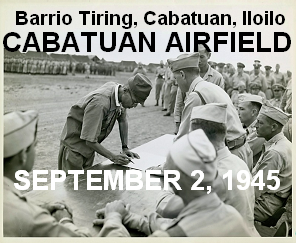
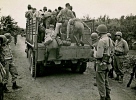
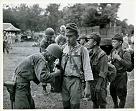
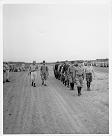
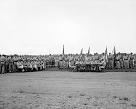
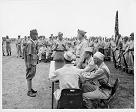
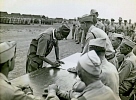
Col. Ryoichi Tozuka signs the surrender instrument
as Col. Raymond G. Stanton looks on.
Cabatuan Airfield
Barrio Tiring, Cabatuan, Iloilo
Panay Island, Philippines, September 2, 1945
|
|
- o -
|
LIST OF ILLUSTRATIONS:
Section 1.1
Page 21. Burning facilities of the Iloilo-Negros Air Express Company (INAEC), the civilian airport near Fort San Pedro, 18 December 1941, as a result of the bombing by Japanese planes
Section 1.2
Page 26. Governor Tomas Confesor
Page 27. Sketch Map of the JA Invasion Operations (16-31 April 1942)
Page 28. Lieutenant Colonel Macario Peralta, commander of the 6th Military District
Section 1.3
Page 29. Garrisons and Sentry Posts of the Seno unit (early August 1942). A total of 762 Japanese soldiers staffed the 15 garrisons in Iloilo, five in Capiz and three in Antique
Page 30. Dr. Fermin G. Caram, appointed by the Japanese as provincial governor
Page 33. Lt. Col. Yasumi Sen�, commander of the Panay garrison unit, the 33rd Independent Infantry Battalion
Section 2.2
Page 39. The Guerrilla Raid on Santa Barbara (November 1942)
Section 2.3
Page 42. The 1st Phase of mopping-up operations in Panay (mid-November - end of December 1942)
Section 3.2
Page 46. Inspecting San Remigio Copper Mine, operated by Ishihara Mining in Antique
Page 46. Guarding the San Remigio Copper Mine
Section 4.1
Page 52. Organization of the Civilian Government in Panay and Romblon Islands (as of October 1943)
Page 54. Organization of the 6th Military District combat units (around May 1943)
Section 4.4
Page 59. The 6th Military District position Map (May 1943), with landing sites and submarine landing sites in Antique
Section 6.1
Page 75. Route Map of the 170th Independent Infantry Battalion (Tozuka Unit), Joint Punitive Expedition (7 July - 31 December 1943)
Section 6.2
Page 76. Lt. Col. Ryoichi Tozuka, Panay garrison commander, commanding officer, 170th Independent Infantry Battalion
Page 77. Location of the Tozuka Unit garrisons (February 1944)
Section 7.3
Page 89. Distribution of JA forces in Iloilo (February 1945)
Section 7.4
Page 92. Organization of the 6th Military District forces (before US Army landing)
Section 8.1
Page 94. The combat situation in Iloilo City the day before US Army landing (17 March 1945)
Page 96.
Page 96.
Section 8.2
Page 98. Kumai on a visit to site of Japanese HQ air raid shelter on the grounds of the Locsin residence (From left, Kumai, a member of Locsin family, and Arturo Sabido). This is where Col. Tozuka and the author had their last operations meeting on 18 March 1945
Page 100. Battle situation in the Jaro suburbs, night of 18 March to daylight of 19 March 1945
Page 101. Kumai at tochika of the Pavia garrison which was annihilated, in postwar Pavia
Page 104. Battle situation of the main JA forces (around 5:00 P.M. 19 March 1945)
Section 8.3
Page 107. Sketch of the mass suicide site (night of 21 March 1945), (based on interviews with local residents)
Page 107. Civilian survivors, among others, on a memorial visit to the suicide site in Sitio Suyac, Barangay Tigbauan, Maasin (25 November 1974)
Page 108. Librada Catalan-Subano's dress on her child (the mother's blood stained this dress)
Section 9.1
Page 110. Japanese Army movements after the US Army landing
Page 112. Japanese troop position in Bocari (August 1945)
Page 113. A view of the hills of the Japanese hold-out at Bocari
Section 11.4
Page 141. Kumamoto City memorial marker, 20 March 1977
The author, Captain Toshimi Kumai, is the former Adjutant of the Japanese Imperial Army's Panay Garrison during WWII. Mr. Kumai initially experienced combat as a Second Lieutenant in the 142nd Regiment of the 65th Brigade (also know as the Nara Corps). In September 1942 he was sent to Panay Island. Following the Japanese surrender, he would serve eleven years in prison for his involvement in repressing guerrilla activity on Panay.
|
|